While comics and cinema are two different forms of storytelling, there are some areas where their expressions can look similar to one another just like how time interacts. This could be how the characters are arranged within a comic to how the shots in a cinema are organized for fluidity. However, the time in comics and cinema are seen differently.
Let’s say that someone wanted to change this small snippet from McCloud’s “Understanding Comics” strips for an example into a movie scene. In this comic example, time is measured through the size of the frames. The side panels are seen as shorter to represent a smaller amount of time passing while the longer panel is seen to represent a longer amount of time passing. Now, if this were within a movie, the side panels would be seen as a few seconds of the individuals speaking their lines. As for the longer panel, it would be translated into a long shot of the man just sitting there thinking to address time.
Now, how about turning a cinema into a comic. One of my favorite childhood movies was “Home Alone” with the battle plan being my favorite part of the movie. In “Home Alone” during the preparation sequence, Kevin is seen setting up different areas of the house with traps before the Wet Bandits come. If this scene was a comic strip, the traps would be seen in different panels.

Comics use their panels by size or order to help explain time while cinema must use shot duration or shot placement to explain time. Even though they have different ways of telling time, they still use these methods to tell their stories.